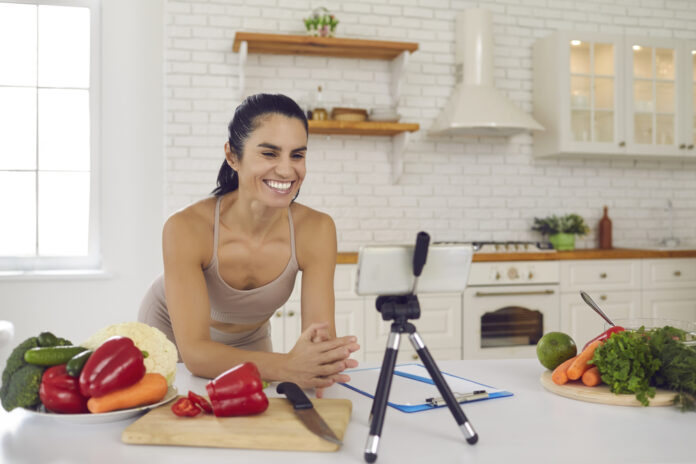By Erin Bradley, CEO and Founder of Zyia Active
Have you ever fallen down a YouTube rabbit hole where you start watching one video, then another, and suddenly, an hour has passed? If so, you’re not alone because video captures our attention like no other form of media — particularly on the internet. One survey found that more than 50% of respondents spent between four and ten hours each week watching videos online. The largest group of respondents, over 27%, watched more than ten hours of online video each week. Given these numbers, it’s no surprise that marketers and entrepreneurs are eager to tap into this enormous audience by making videos of their own.
Unfortunately, many people dread the idea of actually making videos because the process comes with so much anxiety. As humans, we rely heavily on the non-verbal cues our conversation partners send about our messages. This kind of feedback doesn’t exist with video. Instead, we talk into a black hole with no way to gauge how we look or sound to the audience. This unknown is enough to keep some people from ever trying video.
That doesn’t mean we should give up. On-camera confidence is something you can learn with a road map, goals, and some practice. With those valuable new tools in hand, you can start using video to grow your business or personal brand and build customer loyalty.
Five Steps to Build On-Camera Confidence
At Zyia’s recent Basecamp conference, a virtual training event for sales reps, Danielle Hawthorne shared the five-step goal-setting framework she used to transition from a marketing assistant into an entertainment journalist and confidence coach. Goal-setting and confidence-building go hand-in-hand because, over time, the act of achieving what you want creates a cascade of positivity that fuels your belief in yourself.
Under Danielle’s framework, confidence-building becomes a tangible and strategic process we define for ourselves, which becomes incredibly empowering in practice. Here’s how you can use Danielle’s technique to build your on-camera confidence.
Step 1: Set a Goal
Before beginning your journey, you need to define the desired outcome. It’s helpful to use the SMART framework (specific, measurable, attainable, relevant and timely) so your goals stay achievable.
Under the SMART framework, your goal transforms from “I want to be more confident on camera” to “I want to produce and release three videos about topics A, B and C in the next six months.” SMART goals contain more detail than general goals and create action steps you can take to begin moving forward. But more on that later.
Step 2: Find Your Why
You’ll run into challenges during this process, even with the best plan in place. That’s why step two asks you to outline the forces that will keep you moving forward when things get tough. Your why should delve deeper than success or revenue and serve as a guiding light when you feel your confidence faltering.
Start by thinking about why you’re creating this video content. How can you help your audience solve problems, find more success or build a community they’ll love? By moving beyond surface-level motivations, you’ll tap into a wellspring of conviction that can pull you through just about anything.
Step 3: Determine Your Blocks
In the third step, you need to identify what has previously prevented you from achieving your goals. This process begins by envisioning what your life and environment will look like when you’ve reached your goals. At this point, self-limiting thoughts will start rising to the surface. You may tell yourself that you don’t understand the technology, or you won’t look good on camera, or people won’t care what you have to say.
When these thoughts arrive, don’t look away. Instead, write them down in a journal and then flip them into positives you can use as daily affirmations. Rather than saying, “I’m scared of video technology,” say, “I can’t wait to learn something new.” This process is one you can use for the rest of your life because new self-limiting talk will emerge as you continue achieving extraordinary things.
Step 4: Map It Out
Here’s where the rubber starts meeting the road. Set a deadline for your primary goal, and then work backward to create your roadmap. Write down the big action items you know you need to accomplish. Then break your action items down into smaller steps. Assign deadlines to your smaller steps and action items and place them all into chronological order. Suddenly, you’ll have a process to follow until you eventually reach your primary goal.
Step 5: Take Action
Once you have your plan in place, take steps every day to meet your action item deadlines. It’s also important to include time for practice. Learning how to be confident on camera comes from experience as much as it does preparation. You can start practicing by recording yourself doing daily tasks you’re already comfortable with, like making a cup of coffee. As you practice, you’ll also be conditioning your brain to know that this new, unfamiliar action is okay and, after time and repetition, the internal self-limiting talk will begin to fade.
Ultimately, It’s Not About You
As you start crossing to-do items off your list and moving closer to your goal of building on-camera confidence, it’s important to remember one critical point: It’s not about you. You’re not creating videos because you want to be the center of attention. Instead, you’re doing this because you have something to share with your audience. By staying focused on their needs and the value you offer, you’ll remove the anxiety that comes from the unknown.
You’ll be amazed to discover how much your world opens up as you begin accomplishing your goals and building confidence. Once you’ve mastered on-screen appearances, you can use this framework to get from point A to point B, no matter how wide the gap is. With a bit of practice and persistence, you’ll soon realize that nothing is out of reach.
Find a Home-Based Business to Start-Up >>> Hundreds of Business Listings.
















































